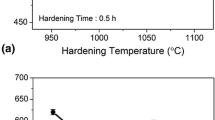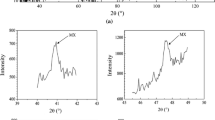Abstract
A series of 4130 steels modified with 0.50 pct Mo and 0.75 pct Mo were tempered at temperatures between 300 and 700 °C for one hour. The changes in the carbide dispersion and matrix substructure produced by tempering were measured by transmission electron microscopy. These measurements were correlated with resistance to hydrogen stress cracking produced by cathodic charging of specimens in three-point bending. Scanning electron microscopy showed that specimens tempered between 300 and 500 °C failed by intergranular cracking while those tempered at higher temperatures failed by a transgranular fracture mode. Auger electron spectroscopy showed that the intergranular fracture was associated with hydrogen interaction with P segregation and carbide formation at prior austenite grain boundaries. Transgranular cracking was initiated at inclusion particles from which cracks propagated to produce flat fracture zones extending over several prior austenite grains. The 4130 steels modified with higher Mo content resisted tempering and showed better hydrogen stress cracking resistance than did the unmodified 4130 steel. The transition in fracture mode is attributed to a decohesion mechanism in the low temperature tempered samples and a pressure mechanism in the highly tempered samples.
Similar content being viewed by others
References
National Association of Corrosion Engineers Materials Requirement, MR-01-75.
E. Snape:Corrosion, 1967, vol. 23, pp. 154–72.
E. Snape:Corrosion, 1968, vol. 24, pp. 261–82.
W. M. Cain and A. R. Troiano:Pet. Eng., 1965, vol. 37, pp. 78–82.
A. R. Troiano:Trans. ASM, 1960, vol. 52, p. 54.
P. J. Grobner, W. C. Hagel, and V. Biss: unpublished research, Climax Molybdenum Co., Ann Arbor, MI.
P. J. Grobner, D. L. Sponseller, and W. W. Cias:Mater. Perform., 1975, vol. 14, pp. 35–43.
J. P. Fraser, G. G. Eldredge, and R. S. Treseder:Corrosion, 1958, vol. 14, pp. 517t.
A. E. Schutz and W. D. Robertson:Corrosion, 1957, vol. 13, p. 437t.
H. L. Craig, Jr., D. O. Sprowls, and D. E. Piper:Handbook on Corrosion Testing and Evaluation, W. H. Ailor, ed., pp. 231–90, John Wiley and Sons, Inc., New York, 1971.
R. T. DeHoff and F. N. Rhines:Quantitative Microscopy, pp. 50 and 181, McGraw-Hill, New York, 1968.
C. A. Apple, R. N. Caron, and G. Krauss:Met. Trans., 1974, vol. 5, pp. 593–99.
R. N. Caron and G. Krauss:Met. Trans., 1972, vol. 3, pp. 2381–89.
R. M. Hobbs, G. W. Larimer, and N. Ridley:J. Iron Steel Inst., 1972, vol. 210, pp. 757–65.
G. Thomas:Met. Trans. A, 1978, vol. 9A, pp. 439–50.
D. L. Williamson, R. G. Schupmann, J. P. Materkowski, and G. Krauss:Met. Trans. A, 1979, vol. 10A, pp. 379–82.
D. Shah and C. Altstetter:Mater. Sci. Eng., 1976, vol. 26, pp. 175–83.
S. K. Banerji, C. J. McMahon, Jr., and H. C. Feng:Met. Trans. A, 1978, vol. 9A, pp. 237–47.
J. P. Materkowski and G. Krauss:Met. Trans. A, 1979, vol. 10A, pp. 1643–51.
R. G. Schupmann: M.S. Thesis, Colorado School of Mines, Golden, CO, 1978.
G. Krauss:Proc. Joint US/Japan Seminar, pp. 138–43, Rensselaer Polytechnic Institute, Troy, NY, June, 1979.
R. D. McCright:Stress Corrosion Cracking and Hydrogen Embrittlement of Iron Base Alloys, pp. 306–25, R. W. Staehle, J. Hochmann, R. D. McCright and J. E. Slater, eds., NACE, Houston, 1977.
R. A. Oriani:Proceedings Conf Fundamental Aspects of Stress Corrosion Cracking, pp. 32–50, R. W. Staehle, A. J. Forty and D. van Rooyen, eds., Houston, 1969.
J. K. Tien:Effect of Hydrogen on Behavior of Materials, pp. 309–26, TMS-AIME, A. W. Thompson and I. M. Bernstein, eds., New York, 1976.
G. M. Pressouyre and I. M. Bernstein:Met. Trans. A, 1978, vol. 9A, p. 1571.
G. M. Pressouyre:Met. Trans. A, 1979, vol. 10A, pp. 1571–73.
A. Ciszewski, T. Radomski, and M. Smialowski:Stress Corrosion Cracking and Hydrogen Embrittlement of Iron Base Alloys, pp. 671–79, R. W. Staehle, J. Hochmann, R. D. McCright, and J. E. Slater, eds., NACE, Houston, 1977.
Author information
Authors and Affiliations
Rights and permissions
About this article
Cite this article
Craig, B.D., Krauss, G. The structure of tempered martensite and its susceptibility to hydrogen stress cracking. Metall Trans A 11, 1799–1808 (1980). https://doi.org/10.1007/BF02655095
Received:
Issue Date:
DOI: https://doi.org/10.1007/BF02655095




